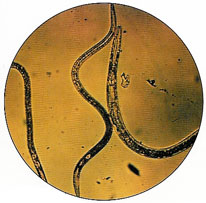Nematoda
Nematodes or roundworms are some of the most abundant animals on earth – some five billion may be in every acre of fertile garden soil. Zoologists estimate that the number of roundworm species ranges from 23,000 to 500,000, with many new species still being described. Some species of nematode may contain millions of eggs at one time and may lay 200 thousands of them daily. Nematodes include many important human parasites.
 |
Phylum Nematoda
1.
Triploblastic, bilateral,
vermiform (resembling a worm in shape; long and slender), unsegmented,
pseudocoelomate
2.
Body round in cross section and covered
by a layered cuticle; molting usually accompanies growth in juveniles
3.
Complete digestive tract; mouth usually
surrounded by lips bearing sense organs
4.
Most with unique excretory system comprised
of one or two renette cells or a set of collecting tubules 5. Body wall has only longitudinal muscles |
Unlike flatworms, which have a diversity of anatomical features, the body forms of different species of roundworms are all very similar. The nematode body is unsegmented, elongate, cylindrical, and tapered at both ends. They have an outer, collagenous cuticle that molts four times during growth (ecdysis) *see life-cycle link below. The cuticle provides protection, maintains internal hydrostatic pressure and, in parasitic species, resists digestion by the host.
The nematode pseudocoelom is a spacious, fluid-filled cavity that contains the visceral organs and forms a hydrostatic skeleton. Roundworms are round because the body muscles contracting against the pseudocoelomic fluid generates equal forces in all directions.
Contraction of longitudinal muscles are the principal means of locomotion in nematodes, creating their characteristic side-to-side trashing movements. Nematodes lack circular muscles and are therefore incapable of changing their body diameter as does an earthworm.
Most nematodes are dioecious and dimorphic, with males being smaller than the females. The long coled gonads lie free in the pseudocoelom. The juveniles undergo four molts, although in some species, the first one or two molts occur in the egg (see life-cycle link below)..
A unique characteristic of nematodes is that each animal has a finite number of cells and this number is species-specific (e.g., all adult Caenorhabditis elegans individuals have 959 cells). This feature has made nematodes an important model organism for studying ageing. It was the firrst multicellular organism to have its genome completely sequenced (please read the article titled "eutely" in Additional Reading).
Roundworms feed on every conceivable source of organic matter–from rotting substances to living tissues of other invertebrates, vertebrates, and plants. They range in size from microscopic to several meters long. Many nematodes are parasites of plants or animals; most others are free-living in marine, freshwater, or soil habitats. Some nematodes play an important role in recycling nutrients in soils and bottom sediments.
Parasitic nematodes
Parasitic nematodes show a number of evolutionary adaptations to their way of life. These include a high reproductive potential, life cycles that increase the likelihood of transmission from one host to another, an enzyme-resistant cuticle, highly resistant eggs, and encysted larvae.
Trichinella spiralis live in the mucosa of the small intestine and other carnivores and omnivores (e.g., pigs), and is responsible for causing trichinosis. In the intestine, the females give birth to live juveniles that enter the circulatory system and eventually penetrate skeletal muscle cells. They encyst in the muscles and remain infective for many years. Transmission to people is most often by ingestion of raw or undercooked pork containing encysted juveniles.
Ascaris lumbricoides is the giant intestinal nematode of humans. It is the most common human roundworm in the world, and at over 18 inches, it is also the largest. It is estimated that 2 billion people are host to this parasite; this means that close to one out of
Hookworms are soil-transmitted nematodes that infect ~700 million people. Juveniles develop on soil contaminated with feces and benefit from shade and moisture to survive. Humans become infected when the juveniles (J3s) penetrate the skin. Children with chronic infection suffer impaired physical and cognitive development.
Pinworms are the most common roundworm parasites in the US. They live in the lower region of the large intestine. At night, females crawl out of the host's anus where they deposit eggs containing first-stage larva causing intense itching.
The filarial worms are elongate, threadlike nematodes that are transmitted by blood-sucking arthropods. These worms live in the tissues or lymphatics where they block the flow of lymph. One symptom of infection with filarial worms is a condition called river blindness, another is elephantiasis. A filiarial worm prevalent in the US is Dirofilaria immitis, which you know as dog heartworm.
Humans can become infected with the Guinea worm when they drink water containing infected freshwater copopods. The treatment for this infection is simple but tedious: The one-meter long worm is rolled out on a matchstick a few centimeters daily until the entire worm has been removed.
Ecdysozoans are united by molecular characteristics and by the presence of a cuticle that is molted during growth. Except in their sensory structures, nematodes lack cilia, a characteristic they share with arthropods. Also in common with some arthropods, the sperm of nematodes is amoeboid.
Nematode life-cycle
Return to the Invertebrate
Zoology Homepage.